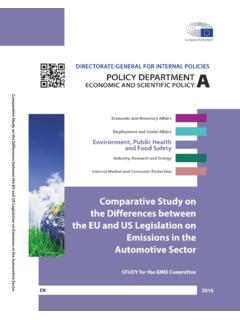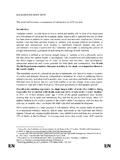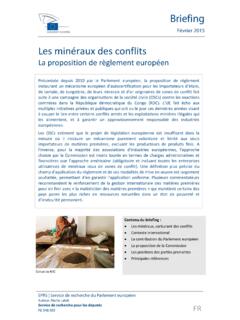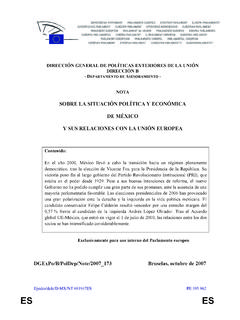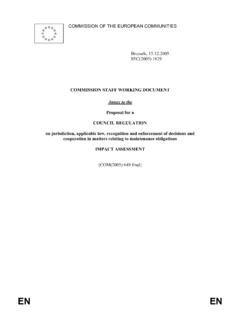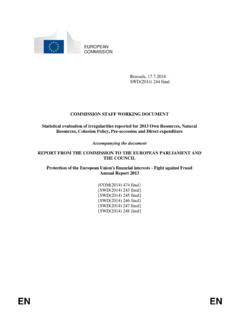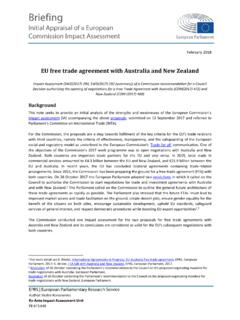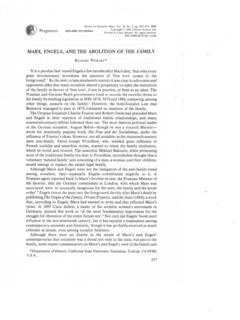Transcription of Briefing Industry 4 - European Parliament
1 BriefingSeptember 2015 EPRS | European Parliamentary Research ServiceAuthor:Ron DaviesMembers' Research forproductivity and growthSUMMARYMany observers believe thatEurope isat the beginningof a new industrial revolution,considered tobe the fourth such leap forward and hence labelled Industry useof sensors,theexpansionof wireless communicationand networks,thedeploymentofincreasingly intelligentrobotsand machines as well as increasedcomputing power at lower cost and the development of 'big data' analytics has thepotential totransform thewaygoods are manufactured in new,digitalindustrial revolution holds the promise ofincreased flexibility inmanufacturing,mass customisation, increasedspeed, betterquality to capture these benefits, enterprises will need toinvest inequipment.
2 Informationand communication technologies (ICTs)and dataanalysisaswell asthe integration of data flows throughout the global value EU supports industrial change through its industrial policy andthroughresearchand infrastructure funding. Member Statesare also sponsoringnational initiatives suchasIndustrie Germany, the Factory of the Future in Franceand Italy,and Catapultcentres in the challenges need for investment, changingbusiness models,data issues, legal questions of liability and intellectual property,standards, andskills mismatchesare among the challenges that must be metifbenefitsaretobe gained from new manufacturing and theseobstaclescan be overcome.
3 Industry may help to reverse thepastdecline inindustrialisationand increase total value added from manufacturingtoa targeted 20% of all value addedby this Briefing : Context What is Industry What will Industry change? ChallengesforIndustry EU policy Member States Stakeholderpositions Main referencesEPRSI ndustry ' Research ServicePage2of10 ContextTheindustrialsector is important to the EU economy and remains a driver of growthand (whichinthis context means manufacturing andexcludesmining, construction and energy)
4 Provides added value through the transformation ofmaterials into only roughly1 in 10enterprises in the EU is classifiedas manufacturing,the sector comprises 2million companies and is responsible for33million jobs. It is alsoresponsible forover80%of exports and80%percent ofprivateresearch and innovation, and as such is one of thekeyelements of , every new job in manufacturing results in the creation ofbetweenonehalf and 2jobsin other the relative contribution of Industry to the EU economy is economy has lost a third of its industrialbaseoverthe past 40 quarter of 2014, the value added by manufacturing to the economy in the EUrepresented totalvalue added.
5 A decline of points sincethe beginning of 'de-industrialisation',a processwhich is alsopresentinotherdevelopedeconomies,is in part due to the rise of manufacturing in other parts ofthe world (notably China),the relocation of labour-intensive work to countries withlower labour costsand global supply chains with supplierslocatedoutside the , the growing services sectorrepresentsan ever-largerproportion of the totalEuropeaneconomy,resulting in a lowerrelativeshare for , inresponse to thisdecline in therelative importance of Industry ,the EuropeanCommission set atargetthat manufacturing should represent 20% of total value addedin the EU by observersfindthis goaloverly ambitious.
6 Many believethatwe are on thebrink ofa new industrial revolution, , which couldboostthe productivityandvalue addedof European industries and stimulate part of its newDigitalSingle Market Strategy, the European Commissionwants to help all industrial sectors exploit new technologies and manage a transitiontoa smart, industrial is Industry is a term applied toa group ofrapid transformations in thedesign,manufacture, operation and service of manufacturing systems and signifies that this is theworld'sfourthindustrial revolution, thesuccessor to threeearlierindustrial revolutions (seeTable1) thatcaused quantum leapsin productivity andchanged the lives of people throughout the world.
7 In the words ofGerman Chancellor Angela Merkel, is 'the comprehensive transformation ofthe whole sphere ofindustrial production through the merging of digital technology andthe internet with conventional Industry '. In short, everything in and around amanufacturing operation (suppliers, the plant, distributors,even the product itself) isdigitallyconnected, providing a highly integrated value in Germany, but the conceptlargelyoverlapsdevelopments that,in otherEuropean countries,may variously be labelled:Smart factories ,the Industrial Internet ofThings,Smartindustry,orAdvanced depends ona number of new and innovative technological developments.
8 The application ofinformation and communication technology (ICT)todigitiseinformationand integrate systemsat all stages of product creation and use(includinglogisticsand supply),bothinside companies andacross company boundaries;EPRSI ndustry ' Research ServicePage3of10 Cyber-physical systemsthat use ICTs tomonitorand control physical processes andsystems. These may involveembeddedsensors,intelligentrobots that can configurethemselves to suit the immediate product to be created,oradditive manufacturing(3D printing)devices; Network communicationsincluding wireless and internet technologiesthatserve tolinkmachines, workproducts,systems andpeople, both within the manufacturingplant, and with suppliers and distributors; Simulation,modellingand virtualisationinthedesignof productsandtheestablishment ofmanufacturing processes.
9 Collection of vast quantities ofdata,and their analysis and exploitation,eitherimmediately on the factory floor, or throughbig dataanalysisandcloud computing; GreaterICT-basedsupport for human workers, includingrobots,augmented realityandintelligent is expected to have amajoreffect on global can deliverestimatedannual efficiency gainsinmanufacturingof between 6% and8%.The Boston Consulting Grouppredicts that in Germany alone, willcontribute1%peryearto GDP over ten years, creatingup to , oneexpert estimates that investment ontheIndustrialInternetwill grow fromUS$20billion in 2012 to more thanUS$500billionin 2020(albeit withslowergrowthafter thatdate)
10 ,andthatvalue addedwill surgefrom$US23billion in 2012 toUS$ in ,Europe is not the only region of the worldto take aninterest United States has established aNational Network forManufacturing Innovationwitha proposed US$1billionof public fundingtobringtogether national research centresinvestigating topics such asdigital manufacturingand in the Asia/Pacific region were expected to invest almostUS$10billionin theIndustrial Internet of Thingsin 2012,with that figure rising to nearlyUS$60billionby the EU isto remain competitive andto reach its goal ofbecomingasmart, sustainable and inclusive economyby 2020, European industrywillneed to capture the potential for productivity and growth that result in awide rangeof changes to manufacturingprocesses,outcomesand business factoriesallowincreasedflexibilityin of the productionprocess.
